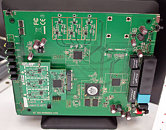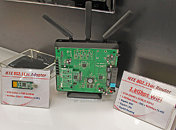Tuesday, March 27th 2012

Edimax Shows Off 802.11ac Router, USB Dongle
Taiwan-based Edimax, which is known more for its low-cost networking hardware, took a big leap, by unveiling its first 802.11ac wireless networking hardware. These include a static router, and a USB adapter. The router uses a Broadcom-made 600 MHz Intensi-fi MIPS32 central processor. This chip has two PCI-Express interfaces, a built-in USB 2.0 host controller, and DDR2 memory controller. It has two WLAN modules, the Broadcom BCM4331 handles 802.11 b/g/n in the 2.40 GHz band, while a Broadcom BCM4360 handles 802.11ac in the 5 GHz band. This module supports network bandwidths up to 1.35 Gbps. Then you have a wired LAN interface, with one gigabit uplink port, and four gigabit downstream ports.
Moving on, Edimax showed off one of the industry's first USB 802.11ac adapters. This dongle uses Broadcom BCM43526 chip, and offers dual-band operation. In the 5 GHz band, it offers bandwidths of up to 900 Mbps, while in the 2.4 GHz band, it offers 300 Mbps. Sadly for this adapter, the USB interface is USB 2.0 HiSpeed, which poses a host bandwidth bottleneck of 480 Mbps. When you factor in things such as the various protocol overheads, the actual bandwidth yield could be much lower. Edimax is yet to name its products, so quite some development is left.
Source:
VR-Zone
Moving on, Edimax showed off one of the industry's first USB 802.11ac adapters. This dongle uses Broadcom BCM43526 chip, and offers dual-band operation. In the 5 GHz band, it offers bandwidths of up to 900 Mbps, while in the 2.4 GHz band, it offers 300 Mbps. Sadly for this adapter, the USB interface is USB 2.0 HiSpeed, which poses a host bandwidth bottleneck of 480 Mbps. When you factor in things such as the various protocol overheads, the actual bandwidth yield could be much lower. Edimax is yet to name its products, so quite some development is left.



3 Comments on Edimax Shows Off 802.11ac Router, USB Dongle
all gigabit ports CHECK
5ghz band CHECK
first to market CHECK
use usb3 to eliminate the 1 possible bottleneck... UMM